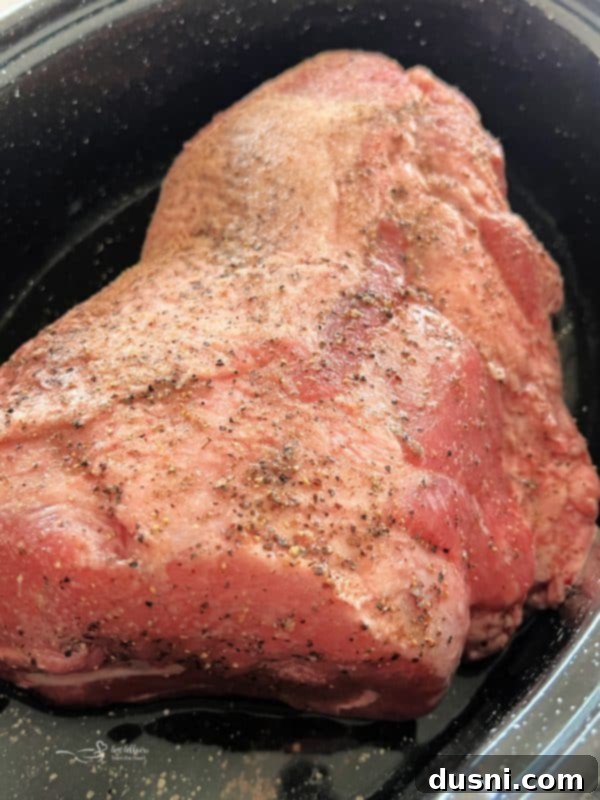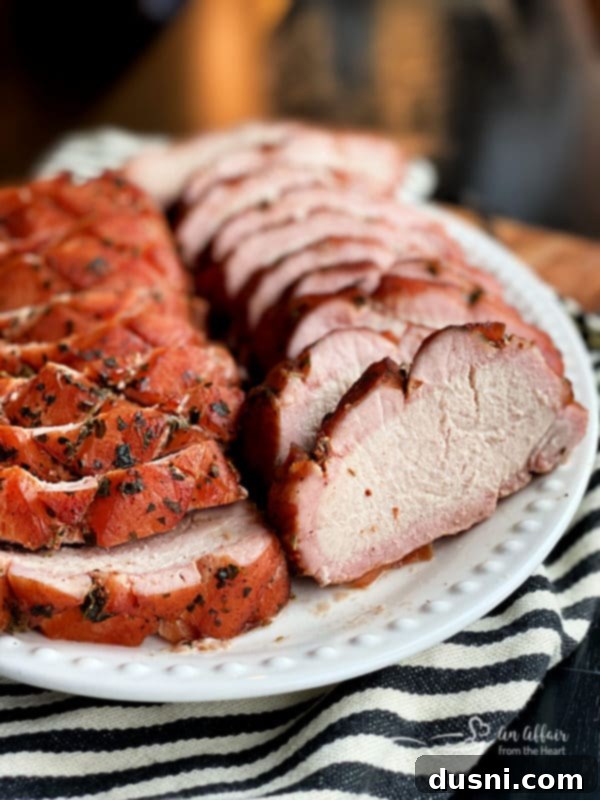Fork-Tender Oven Roasted Pork Shoulder with Rich Homemade Gravy: A Timeless Family Recipe
This incredible recipe for roasted Pork Roast and Gravy promises a truly fork-tender pork shoulder, enveloped in a luscious, flavorful gravy. It’s the quintessential meal for Sunday dinner, special occasions, or any time you crave profound comfort food. The unique cooking method ensures a perfectly seared exterior, which is key to developing the most delicious, rich gravy from the pan drippings. Serve it alongside creamy mashed potatoes, and prepare for beaming smiles around the table.

If the thought of creating a succulent pork roast with a homemade gravy from scratch in your own oven has ever intimidated you, consider this your friendly push to make it happen. This cherished recipe has been passed down through generations in my family, from my grandmother to my mother, and now to me. It’s one of those magical dishes where the moment you step into the house, the heavenly aroma envelops you, instantly stirring your appetite. The entire baking process fills your home with an irresistible scent, but the real star is the thick, rich gravy it yields. This isn’t just a meal; it’s a pure comfort food experience that I’ve savored throughout my life.
The Enduring Appeal of Classic Oven-Roasted Pork and Gravy
Crafted with just a few simple, wholesome ingredients, this pork roast and gravy recipe slowly cooks a substantial cut of pork at a low temperature. This gentle, extended cooking method is the secret to achieving fall-off-your-fork, tender chunks of meat that are exquisitely bathed in a thick, rich gravy made directly from the flavorful pan drippings. Whether you’re planning a sophisticated dinner party, a cozy Sunday supper, or simply an elevated weeknight meal, this dish is versatile enough for any occasion. It pairs wonderfully with a crisp green salad, steamed warm vegetables, or a generous scoop of creamy mashed potatoes, creating a truly perfect and satisfying meal.
This post is proudly sponsored by Iowa Pork. All opinions, however, along with my lifelong passion for pork recipes and quality Iowa Pork, are entirely my own.
Why This Old-Fashioned Pork Roast Recipe is a Family Favorite

This old-fashioned pork roast and gravy recipe isn’t just about taste; it’s about tradition, comfort, and ease. It’s fancy enough to impress guests at a special occasion or a dinner party, yet so straightforward that you’ll feel confident making it for an everyday family meal. One of its greatest advantages is the flexibility it offers. You can easily prepare it ahead of time and gently reheat it the next day, which is a lifesaver when you have a busy schedule. The leftovers are notoriously delicious, though you might find yourself with none, as this dish tends to disappear quickly! If you’re a fan of rich, tender pork bathed in gravy, you’ll also adore these other recipes: The Forgotten Pork Roast, Apple Glazed Smoked Ham, and these crispy Breaded Pork Cutlets.
The Secret to a Truly Tender Pork Roast: Low and Slow Cooking
The key to achieving an incredibly soft and tender pork roast lies in the low-temperature roasting process outlined in this recipe. We roast the pork at a steady, gentle temperature for several hours. This extended, low-heat cooking allows the connective tissues within the pork shoulder to slowly break down, transforming tough fibers into succulent, melt-in-your-mouth gelatin. While you might be tempted to increase the oven temperature to speed up the cooking, I strongly advise against it. Higher temperatures can cause the meat to dry out and become tough, completely defeating the purpose of this recipe. If you’re looking for a quick pork dish, there are other fantastic options like this Sweet Balsamic Glazed Pork Tenderloin or this Pork Loin Roast With Balsamic Cranberry Sauce, which are designed for faster cooking.
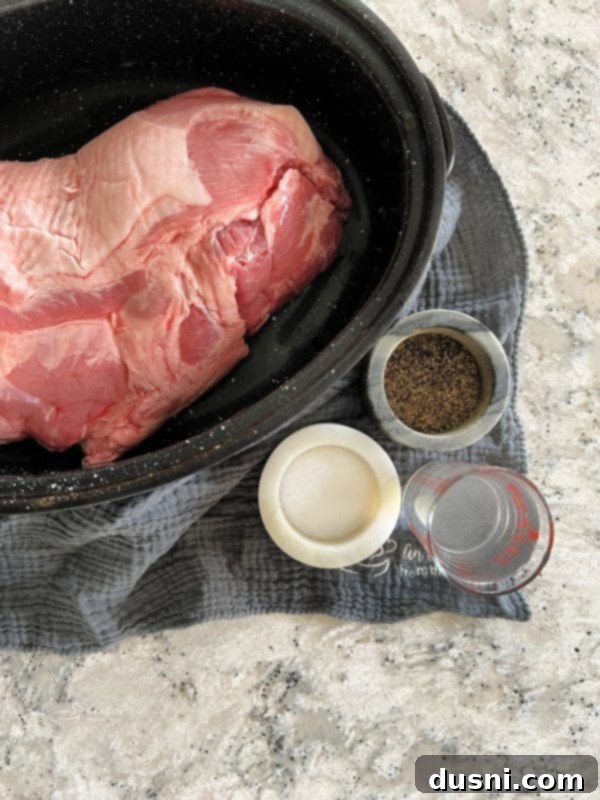
Essential Ingredients for This Homemade Pork Roast Gravy Recipe
For the complete list of ingredients and detailed instructions, please scroll to the bottom of this post for the full printable recipe card. Here’s a closer look at what you’ll need and why each component is crucial:
For the Roast:
- Pork Shoulder Roast: This is the star of our dish. Aim for a roast weighing between 4 and 5 pounds. I often use a bone-in roast, as the bone adds extra flavor and moisture during cooking, but a boneless pork shoulder roast will also work beautifully. Pork shoulder, also known as Boston butt or picnic roast, is ideal for slow roasting due to its generous marbling and connective tissue, which break down into rich flavors and tender textures.
- Salt & Pepper: Simple yet indispensable. Freshly ground black pepper and a good quality salt are essential for seasoning the pork and enhancing its natural flavors. Don’t underestimate their power to create a delicious crust.
- Water: A small amount of water in the roasting pan helps create steam, keeping the roast moist, and more importantly, it forms the base for our incredible pan drippings, preventing them from burning onto the pan.
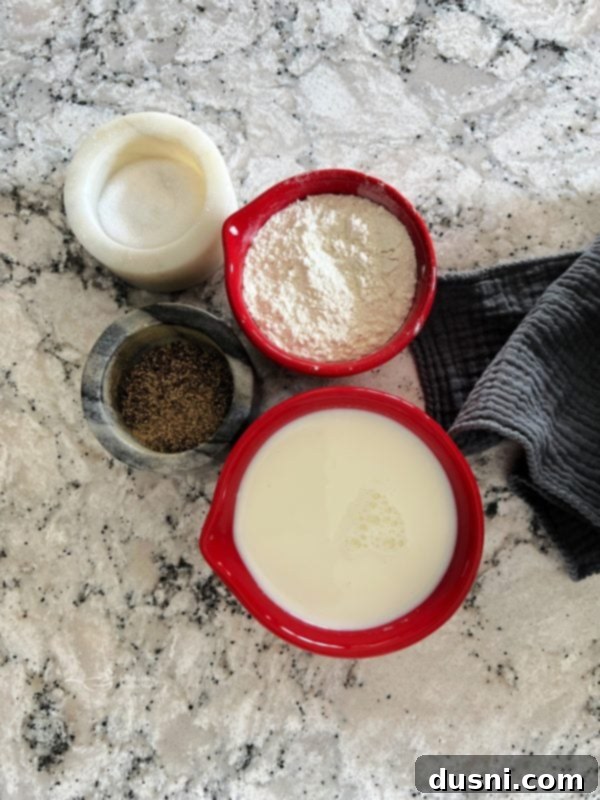
To Make the Gravy for Pork Roast:
- Water: I have a secret weapon for incredibly flavorful gravy: potato water! About 30 minutes before my pork roast is done, I start boiling potatoes on the stove for mashed potatoes. The starchy water from those boiled potatoes adds an amazing depth and thickness to the gravy. If you don’t have potato water, regular water or even chicken or beef broth will work perfectly fine.
- Milk: Any type of milk can be used to make this gravy recipe. The higher the fat content (e.g., whole milk), the richer and creamier your gravy will be, but 2% or even skim milk will still yield a delicious result. For a dairy-free option, vegetable or chicken broth works well.
- Flour: All-purpose flour is our thickening agent. When combined with milk, it creates a “slurry” that, when whisked into the hot pan drippings, will thicken the gravy to a perfect consistency.
- Salt and Pepper: Just like with the roast, these seasonings are crucial for balancing and enhancing the flavors of your gravy. You’ll add them to taste at the end, allowing you to perfect the seasoning.
How to Cook a Pork Roast in the Oven for Maximum Tenderness
Preparing this tender pork roast is incredibly simple, requiring just a few straightforward steps:
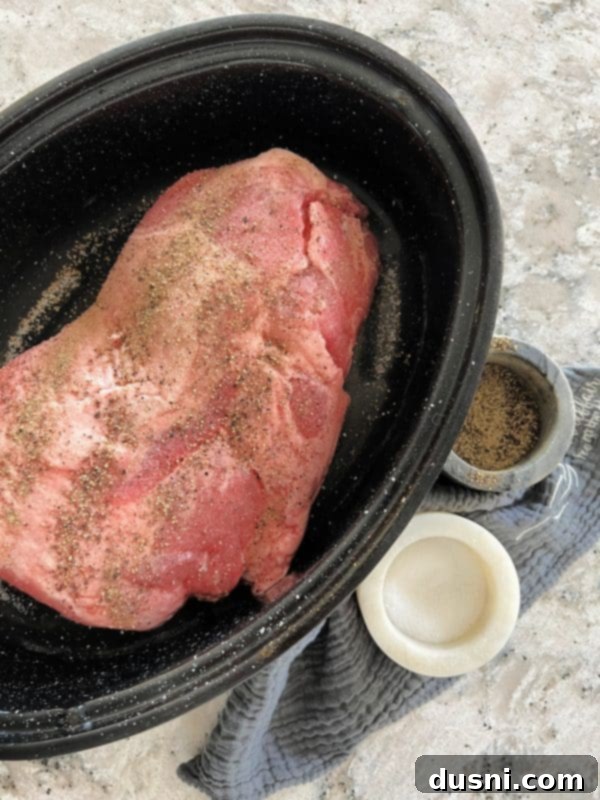
1. **Prepare the Roast:** Begin by preheating your oven to 325 degrees Fahrenheit (160 degrees Celsius). Place your pork shoulder roast in a sturdy roasting pan. Generously sprinkle it with salt and pepper, then rub the seasonings into the meat, ensuring it’s evenly coated. This initial seasoning is vital for building flavor.

2. **Add Liquid to the Pan:** Next, pour about ½ cup of water into the bottom of the roasting pan. This liquid will help prevent the pan drippings from burning and create a flavorful base for your gravy.
3. **Roast Uncovered:** Place the roasting pan, uncovered, into your preheated oven. Bake the roast for approximately 20 minutes per pound, or until the internal temperature reaches 170 degrees Fahrenheit (77 degrees Celsius) when measured with a reliable meat thermometer. Roasting uncovered allows the exterior of the pork to develop a beautiful, rich brown crust, which is essential for creating the deepest, most savory pan drippings for your gravy.
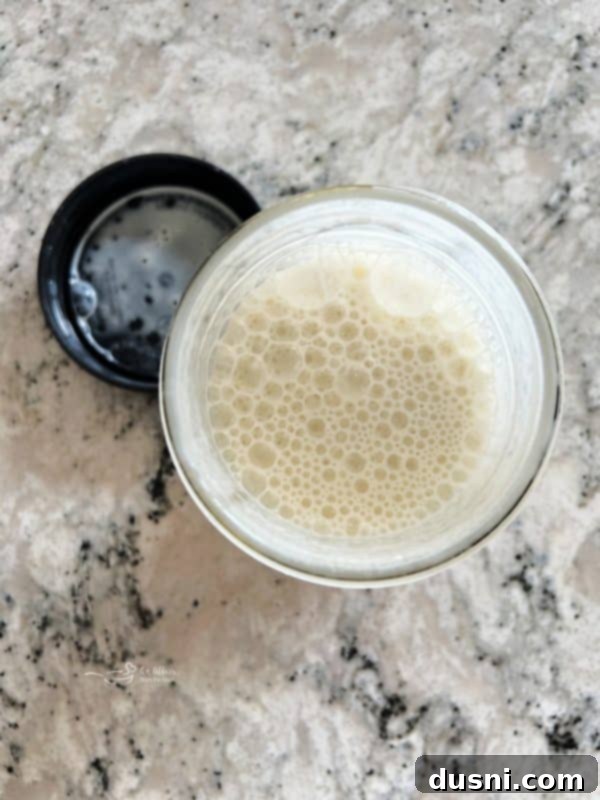
4. **Rest the Roast:** Once the pork reaches the desired internal temperature, carefully remove it from the oven. Transfer the roast to a cutting board and let it rest for at least 15-20 minutes before carving. Resting is a critical step that allows the juices to redistribute throughout the meat, ensuring a moist and tender result. While the roast rests, it’s the perfect time to prepare your homemade gravy.
5. **Prepare the Gravy Slurry:** To make the homemade gravy, combine the milk and flour in a jar or a small bowl. Whisk vigorously until all lumps are completely gone and you have a smooth slurry. Shaking the mixture in a sealed jar or using an immersion blender are also excellent methods for achieving a lump-free mixture.

6. **Deglaze the Pan:** Place the roasting pan, with all the delicious pork drippings still inside, directly on your stovetop over medium heat. Add 2 cups of water (or your preferred potato water or broth). Bring the liquid to a slow boil, scraping up any browned bits from the bottom of the pan with a wooden spoon. These browned bits are packed with flavor and are essential for a rich gravy.

7. **Thicken the Gravy:** Once the drippings are bubbling, slowly pour in the milk and flour mixture (slurry) while continuously whisking. This gradual addition and constant whisking will prevent lumps and ensure a smooth, creamy gravy.
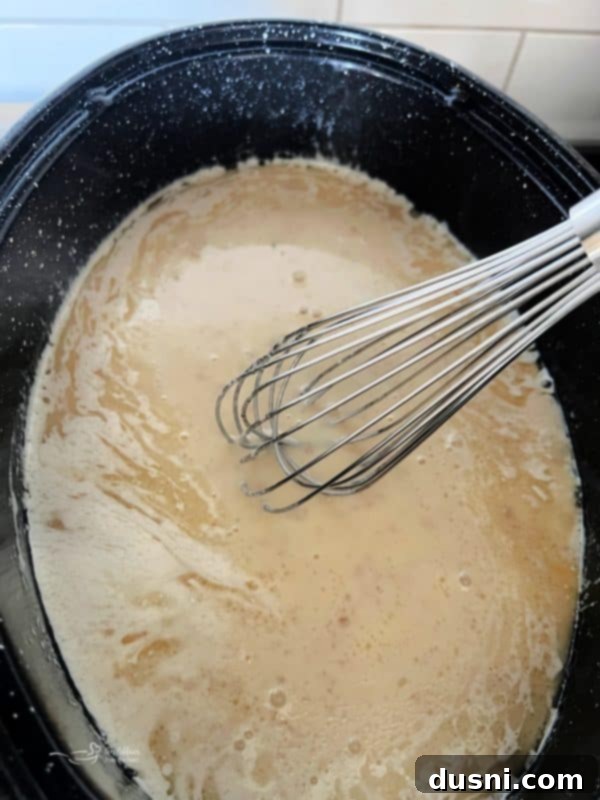
8. **Simmer and Season:** Reduce the heat to low and continue to simmer the gravy, whisking occasionally, until it reaches your desired thickness. The gravy will naturally thicken as it cooks. Finally, taste the gravy and season with additional salt and black pepper as needed. Adjust to your personal preference.
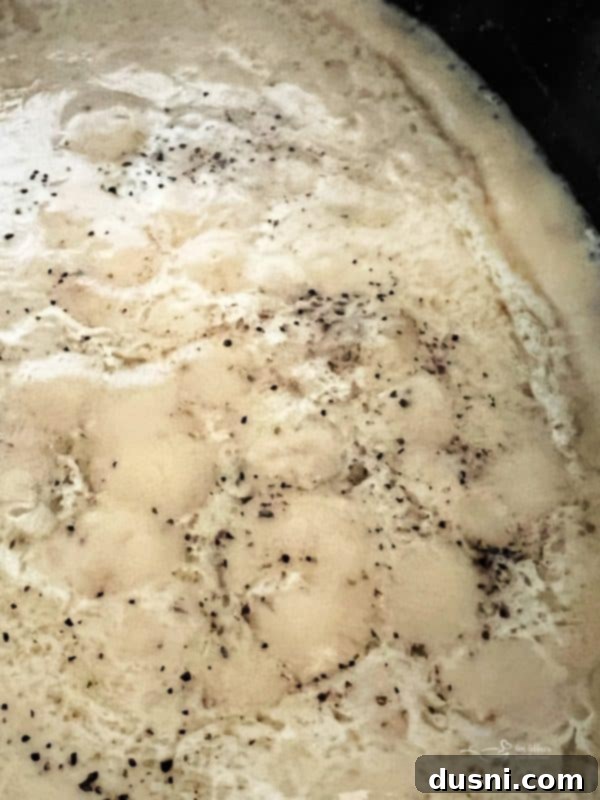
Serve this delectable pork roast sliced or pulled, generously topped with an abundance of that rich, homemade gravy, preferably alongside a mountain of creamy mashed potatoes. This combination is pure culinary bliss!
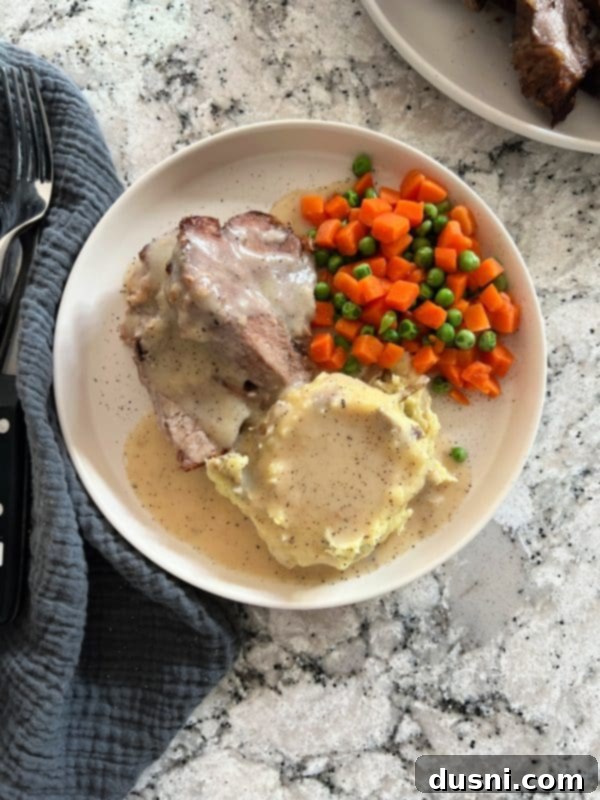
A Quick Note on My Experience: I cooked my almost 5-pound Pork Shoulder Roast for 2 ½ hours at 325 degrees Fahrenheit. It measured 170 degrees internally, and the outside developed a beautiful, deep brown and crisp crust, while the inside remained incredibly moist and tender. That rich brown color on the outside isn’t just for aesthetics; it’s what creates the very best pork gravy!
Storing Leftovers: Allow any leftover pork roast and gravy to cool completely to room temperature. Store the roast wrapped tightly in aluminum foil or in an airtight container in the refrigerator for up to 3 days. The tender pork roast can also be frozen for up to 3 months. To reheat, gently warm in the oven with a splash of broth or water to keep it moist, or reheat smaller portions in the microwave. The gravy can be reheated gently on the stovetop, whisking occasionally, and thinned with a little water or broth if it’s too thick.
Love this recipe? Pin it for later!
If you adore this delicious roast pork and gravy recipe as much as we do, make sure you don’t lose it! Pin it to your favorite Pinterest recipe board now so you can easily find it whenever that comfort food craving strikes!
What is a Pork Shoulder Roast? Understanding Your Cut of Meat
Pork shoulder is an incredibly versatile and flavorful cut of meat that, when cooked properly, becomes exquisitely tender and rich. Its robust nature makes it suitable for a wide range of recipes, from slow-roasted dishes to pulled pork. Understanding what to look for when selecting pork shoulder at the meat counter is important for the best results.
You’ll often find pork shoulder sold under various names, which can sometimes be confusing. Common labels include “picnic roast,” “Boston butt,” “blade roast,” and simply “pork butt.” Despite these different names, they all refer to parts of the pig’s shoulder, each with slightly different characteristics. The Boston butt, for instance, comes from the upper part of the shoulder and is well-marbled, making it excellent for roasting and pulled pork. The picnic roast, from the lower part of the shoulder, has more bone and skin, offering a different flavor profile. This versatile cut lends itself beautifully to diverse cooking techniques, including braising, smoking, roasting, grilling, and slow cooking. Pork Shoulder is, of course, most popularly known for making the best pulled pork due to its ability to become incredibly tender and shred easily.
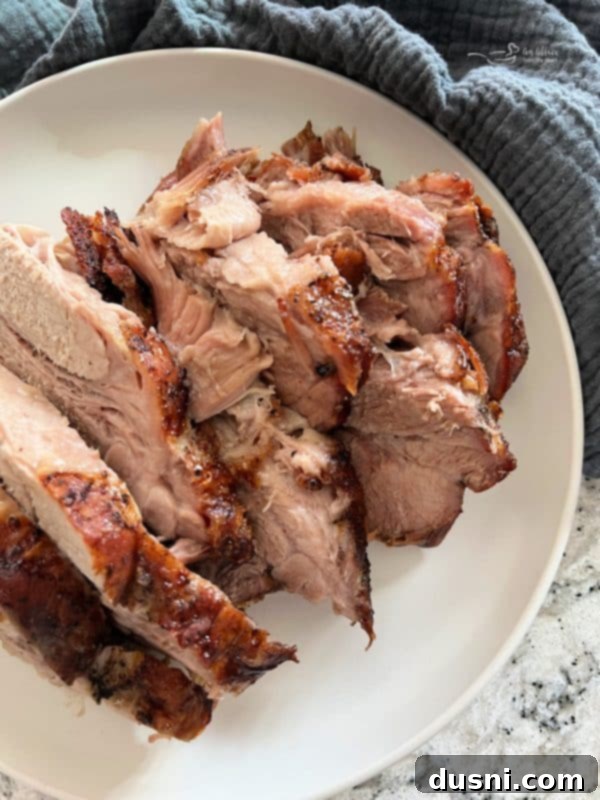
Frequently Asked Questions (FAQs) About Roasting Pork
- Does pork roast get more tender the longer you cook it? Yes, generally, pork roast becomes more tender the longer it cooks, especially when cooked at a low temperature. This slow process allows the connective tissues to break down into gelatin, resulting in a succulent texture. However, it’s crucial to strike a balance; overcooking can eventually dry out the roast, even if it’s technically “tender.” Always monitor the internal temperature.
- Is it better to cook a pork roast slow or fast? For cuts like pork shoulder, a “low and slow” approach is almost always preferred for the most tender and juicy results. This method allows fat to render and connective tissues to melt gradually. Faster, high-heat cooking is typically reserved for leaner cuts like tenderloin or loin, which can dry out easily with prolonged cooking.
- Is it best to cook a pork roast covered or uncovered? For this particular recipe and many other roasts, I highly recommend cooking your pork roast uncovered. This method allows the exterior to brown beautifully, forming a delicious, slightly crisp crust. This browning, known as the Maillard reaction, also contributes significantly to the depth of flavor in your pan drippings, which are the foundation of your rich gravy.
- Do I need to sear the pork roast before roasting? For this specific recipe, you do not need to sear the pork roast before placing it in the oven. The initial roasting at a slightly higher temperature (or just the duration of the uncovered cooking) allows the surface to brown and develop flavor naturally, contributing to the drippings without an extra searing step.
- What is the best way to cook pork so it is tender? Achieving tender pork largely depends on the cut of meat. For tougher, fattier cuts like pork shoulder, slow cooking methods such as roasting at a low temperature, braising, or using a slow cooker are best. For leaner cuts like tenderloin, quick high-heat methods like pan-searing or grilling to the correct internal temperature are key to tenderness.
- How long to cook a 4 lb pork roast at 250 degrees? The cooking time for a 4 lb pork roast at 250 degrees Fahrenheit will vary based on whether it is bone-in or boneless, and its exact thickness. A bone-in roast typically requires longer, often between 6 and 8 hours, while a boneless cut might need approximately 3-4 hours. Always use a meat thermometer to ensure it reaches the safe internal temperature of 170°F for pork shoulder.
- What temperature should pork roast be cooked to? While USDA guidelines suggest 145°F for leaner cuts like tenderloin (followed by a 3-minute rest), for cuts like pork shoulder that benefit from being very tender and shreddable, cooking to a higher internal temperature of 170°F (77°C) to 195°F (90°C) is often recommended. This higher temperature ensures the collagen breaks down thoroughly, making the meat incredibly tender and easy to pull apart.
- Can I add vegetables to the roasting pan with the pork? Absolutely! Adding root vegetables like carrots, potatoes, onions, or celery to the roasting pan about halfway through the cooking process can infuse them with the delicious pork drippings. Just make sure there’s enough liquid in the pan to prevent them from drying out or burning.
Creative Substitutions for Your Recipe
Don’t be afraid to get creative in the kitchen! Remember that when it comes to making substitutions in recipes, the goal is to tailor the dish to your personal taste, dietary preferences, or simply what you have on hand. Make it your own!
-
Thickener Alternatives: Instead of all-purpose flour for your gravy slurry, you can use cornstarch. For every tablespoon of flour, use about half a tablespoon of cornstarch (mixed with an equal amount of cold liquid) to achieve a similar thickening power. Cornstarch gravy tends to be a bit shinier.
-
Pork Cut Alternatives: While pork shoulder is highly recommended for its tenderness and flavor, you can switch up the pork cut. A pork butt (which is also part of the shoulder) or even a pork loin roast can be used. Just be aware that leaner cuts like pork loin will cook faster and may require adjustments to cooking time and temperature to prevent drying out.
-
Dairy-Free Gravy: For a delicious dairy-free gravy, simply use chicken broth, beef stock, or even vegetable broth instead of milk when making your slurry. The flavor profile will be slightly different but still incredibly savory and satisfying.
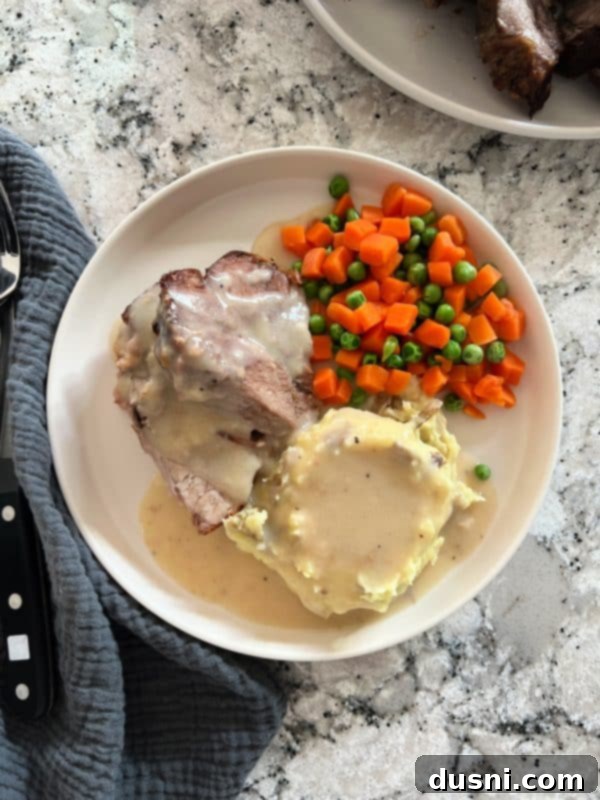
Expert Tips & Tricks for the Perfect Pork Roast
-
Room Temperature Roast: Always allow your pork roast to come to room temperature for about 30-60 minutes before cooking it. This promotes more even cooking, preventing the outside from overcooking while the inside struggles to reach temperature.
-
Enhanced Seasoning: To add an extra layer of flavor to your pork, consider sprinkling it with garlic powder and onion powder in addition to the salt and pepper. A dash of paprika or a sprinkle of dried herbs like thyme or rosemary can also elevate the taste profile.
-
Gravy with a Twist: For a touch of sophistication and depth, pour in a splash of dry white wine or even a small amount of apple cider vinegar into the pan drippings when deglazing. The acidity will brighten the flavors of the gravy and add a subtle tang.
-
Use a Roasting Rack: While not strictly necessary for this recipe, using a roasting rack within your pan can help lift the pork out of its drippings, allowing for more even air circulation around the roast and promoting a crispier exterior. It also makes it easier to remove the roast before making the gravy.
The Enduring Love for Pork
While I may not have grown up on an Iowa farm like my husband did, pork was a staple in my childhood home. My Mom’s Pork Chops and Mushroom Gravy was one of my all-time favorite comfort meals, and it’s a recipe I frequently make for my own children today. Little do they know, as they happily enjoy my pork recipes, that I’m secretly smiling, fully aware of pork’s impressive nutritional value. Pork is a fantastic source of protein, vitamins, and minerals, making it a healthy and delicious choice for any meal.
More Delicious Pork Recipes to Explore
There are so many wonderful cuts of pork to enjoy, each with its own unique flavor and texture. I’m delighted to share many more pork recipes on my website for you to discover. Keep in mind that different cuts often require specific cooking techniques and distinct internal cooking temperatures for optimal results. Thankfully, Iowa Pork makes it incredibly easy to determine those perfect internal temperatures with their comprehensive Pork Cooking Temperature Guide, ensuring your pork is always cooked to perfection.
- Smoked Pork Loin (pictured above)
- Ham & Bean Soup
-
Breaded Pork Tenderloin Sandwich
-
BBQ Pork Ribs
-
Baked Pork Chops With Stuffing
-
Dr. Pepper Pork Ribs

Be sure to follow along with Iowa Pork on Instagram, Facebook, Pinterest, and Twitter for an abundance of delicious pork recipes all year round!

This simple yet elegant recipe masterfully slow-cooks your pork roast to absolute perfection, resulting in incredibly tender meat. When topped with the rich, thick, and delicious homemade gravy, every bite is a culinary delight that will have everyone at your table asking for seconds. It’s a testament to the power of classic cooking techniques and wholesome ingredients.

LIKE THIS RECIPE?
Don’t forget to give it a ⭐️⭐️⭐️⭐️⭐️ star rating and
leave a comment below the recipe!
Print Recipe
Pork Roast and Gravy
Equipment
-
12-Piece Black Sharp Knife Set with Covers, Cutting Board and Sharpener
-
Granite Ware Covered Oval Roaster, 13 inches, Black
-
Lodge 6 Quart Enameled Cast Iron Dutch Oven. Classic Red Enamel Dutch Oven (Island Spice Red)
-
Whisks for Cooking, 3 Pack Stainless Steel Whisk
Ingredients
For the Roast:
- 4 lbs Pork Shoulder Roast 4-5 pounds
- 1 ½ – 2 teaspoons salt
- 1 teaspoon pepper
- ½ cup water
For the Gravy:
- 2 cups water
- 1 ¼ cups milk
- ½ cup flour
- Salt and Pepper
Instructions
-
Preheat oven to 325 degrees. Place roast in a roasting pan, sprinkles with salt and pepper, and rub into roast. Add water to the bottom of the pan.
-
Place the roaster, uncovered in the preheated oven and bake for about 20 minutes per pound or until the internal temperature of the roast reads 145 degrees F. *see notes
-
In a jar, mix together milk and flour until all lumps are gone. Shaking or using an emulsion blender works great)
-
Remove the roast from the pan and set it aside. Place the roasting pan on the stove on Medium heat, add 2 cups of water (I typically use my potato water from my mashed potatoes, but you don’t have to) Bring to a slow boil.
-
Pour the milk mixture into the bubbling drippings and whisk until incorporated. Turn the heat to low. The gravy will thicken as it cooks.
-
Serve the roast with mashed potatoes and lots of gravy over top.
Notes
Nutrition


